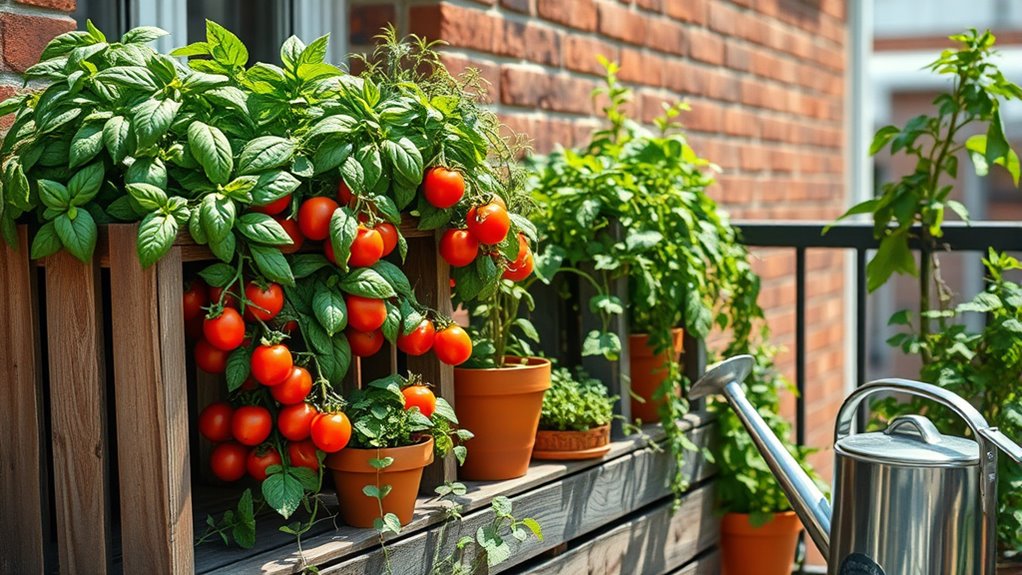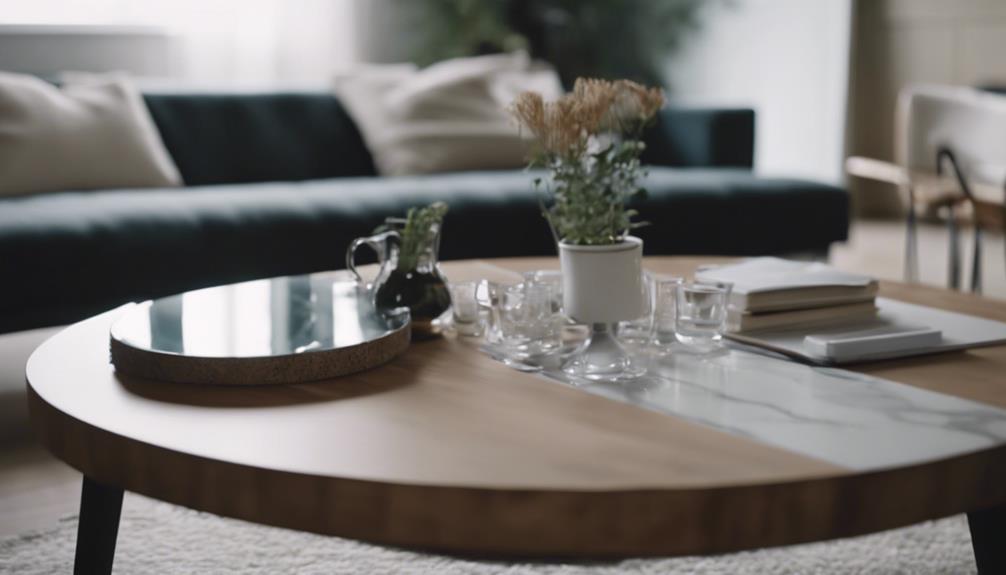Urban gardening in small spaces allows you to transform limited areas into vibrant, productive green refuges. You can grow herbs like basil and mint, along with vegetables such as cherry tomatoes and lettuce, all in containers or vertical setups. Place your plants where they’ll get enough sunlight and use quality soil and regular watering. Adding decorative touches makes your garden inviting. Keep going, and you’ll discover simple tips to maximize your small space and enjoy fresh, homegrown produce.
Key Takeaways
- Select compact, easy-to-grow herbs and vegetables suited for container gardening, like basil, mint, cherry tomatoes, and lettuce.
- Use containers with proper drainage and high-quality potting soil to ensure healthy plant growth.
- Maximize space by incorporating vertical gardening options such as wall planters and hanging baskets.
- Place containers in spots with 4-6 hours of direct sunlight or supplement with grow lights if needed.
- Maintain regular watering, fertilizing, and pest control to keep herbs and vegetables vibrant and productive.

Urban gardening transforms small city spaces into vibrant green refuges, giving you the opportunity to grow your own herbs, vegetables, and flowers even in limited areas. Whether you have a tiny balcony, a small backyard, or a few windowsills, you can create a thriving garden that adds beauty, freshness, and sustainability to your daily life. The key is to maximize your space with thoughtful planning and creative container choices. You don’t need a sprawling yard to enjoy the benefits of growing your own food; a little effort and imagination can turn any corner into a productive garden.
Transform small spaces into lush, productive urban gardens with thoughtful planning and creative container solutions.
Start by selecting compact, easy-to-grow plants suited for small spaces. Herbs like basil, mint, parsley, and cilantro are excellent choices because they don’t require much room and can thrive in pots on your windowsill or balcony. Vegetables such as cherry tomatoes, lettuce, radishes, and peppers also do well in containers, provided they receive enough sunlight. When choosing containers, opt for ones with proper drainage to prevent waterlogging, and use high-quality potting soil that retains moisture but drains well. This guarantees your plants stay healthy and vibrant.
Position your containers where they’ll receive ample sunlight; most herbs and vegetables need at least 4-6 hours of direct sunlight daily. If sunlight is limited, consider using grow lights to supplement natural light. Vertical gardening can further maximize your space by allowing you to grow upwards. Install wall-mounted planters, hanging baskets, or tiered plant stands to make use of vertical surfaces. This approach not only conserves ground space but also creates an eye-catching display that elevates your small garden.
Regular watering and maintenance are vital to keep your plants thriving. Since containers tend to dry out faster than ground soil, check their moisture levels frequently and water as needed. Fertilize periodically with organic options to provide essential nutrients. Keep an eye out for pests and diseases, and address issues promptly to prevent spread. Harvest your herbs and vegetables when they’re ripe to enjoy fresh, flavorful produce, and to encourage continued growth.
Urban gardening in small spaces is as much about creativity as it is about cultivation. Use decorative elements like colorful pots, trellises, or garden statues to personalize your space and make it inviting. Even with limited room, you can create a lush, productive oasis that offers fresh ingredients, brightens your environment, and gives you a satisfying connection to nature. Utilizing high-quality potting soil can significantly improve plant health and yield, ensuring your urban garden thrives. With a little planning and care, your small urban garden will flourish, proving that you don’t need acres of land to enjoy the benefits of homegrown herbs and vegetables.
Frequently Asked Questions
What Are the Best Herbs for Small Balcony Gardens?
You should consider growing basil, mint, parsley, chives, and thyme on your small balcony. These herbs thrive in containers and don’t require much space, making them perfect for limited areas. Basil adds flavor to dishes, mint freshens drinks, and parsley boosts your meals. Chives and thyme are low-maintenance. With proper watering and sunlight, you’ll enjoy fresh herbs right at your fingertips, enhancing your cooking experience daily.
How Do I Prevent Pests in Limited Space Gardens?
To prevent pests in your small garden, start by choosing resistant plant varieties and keeping your space clean. Regularly inspect plants for signs of pests and remove them promptly. Use natural deterrents like neem oil or insecticidal soap to protect your herbs and vegetables. Encourage beneficial insects such as ladybugs, and avoid overwatering, which can attract pests. Maintaining healthy plants is your best defense against infestations.
Which Containers Are Most Suitable for Urban Gardening?
A picture is worth a thousand words, so choose your containers wisely. You should opt for lightweight, durable options like plastic, resin, or fiberglass planters, which are easy to move and withstand weather. Raised beds and hanging baskets also work well for maximizing space. Make certain your containers have drainage holes; otherwise, your plants might drown. Pick containers that match your plants’ size and your aesthetic for a thriving urban garden.
How Often Should I Water My Urban Garden Plants?
You should water your urban garden plants daily, especially during hot weather, to keep the soil consistently moist but not waterlogged. Check the top inch of soil; if it feels dry, it’s time to water. For containers, guarantee proper drainage and avoid letting plants sit in standing water. Adjust your watering frequency based on plant type, weather conditions, and container size to promote healthy growth.
Can Urban Gardens Support Year-Round Vegetable Growth?
Yes, urban gardens can support year-round vegetable growth, but it takes effort. Imagine vibrant greens thriving amidst concrete jungles, temperature controls, and protective covers. You’ll need to choose hardy vegetables, use season extension techniques like cold frames or greenhouses, and stay vigilant about pests. With dedication, you transform a tiny space into a lush, productive oasis that provides fresh vegetables all year long, no matter the city’s hustle.
Conclusion
Urban gardening lets you grow herbs and vegetables even in tight spaces. With over 35% of city dwellers engaging in small-scale gardening, it proves you don’t need a backyard to enjoy fresh produce. Whether on balconies or windowsills, you can create a thriving green space. So go ahead, start planting today—your garden can be a lush, productive oasis amid the city’s hustle. It’s a simple way to boost your well-being and enjoy healthier, tastier food.









